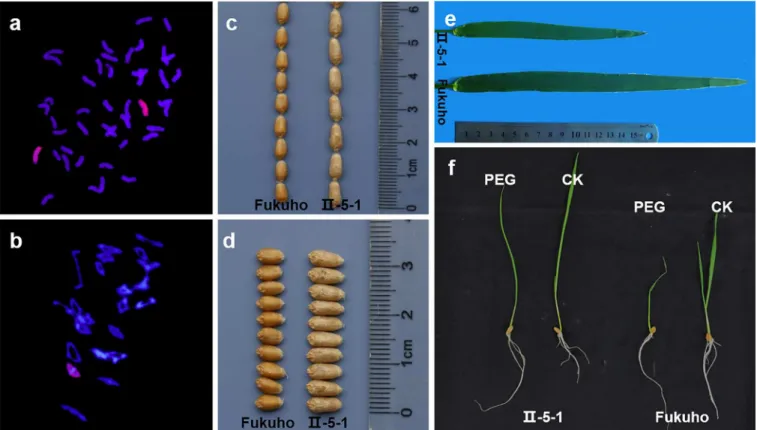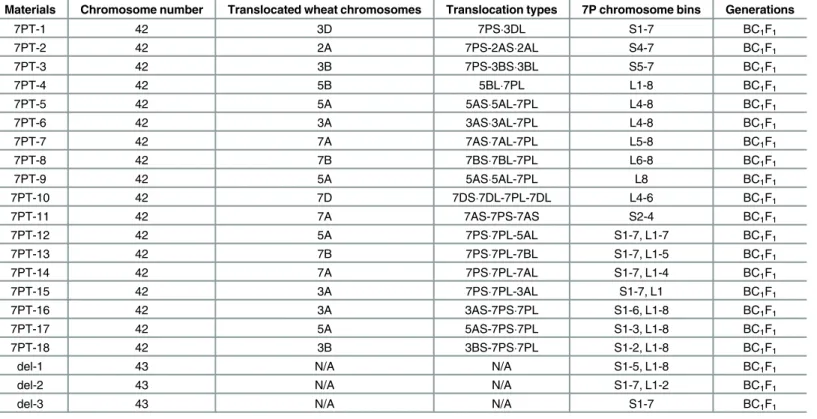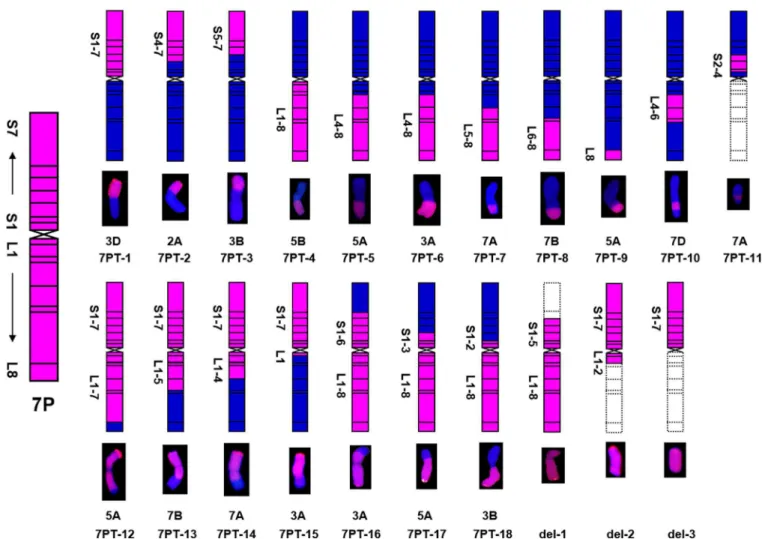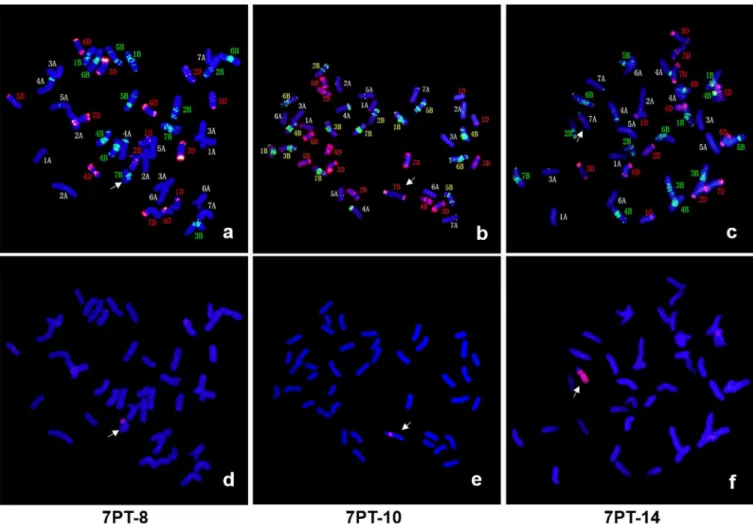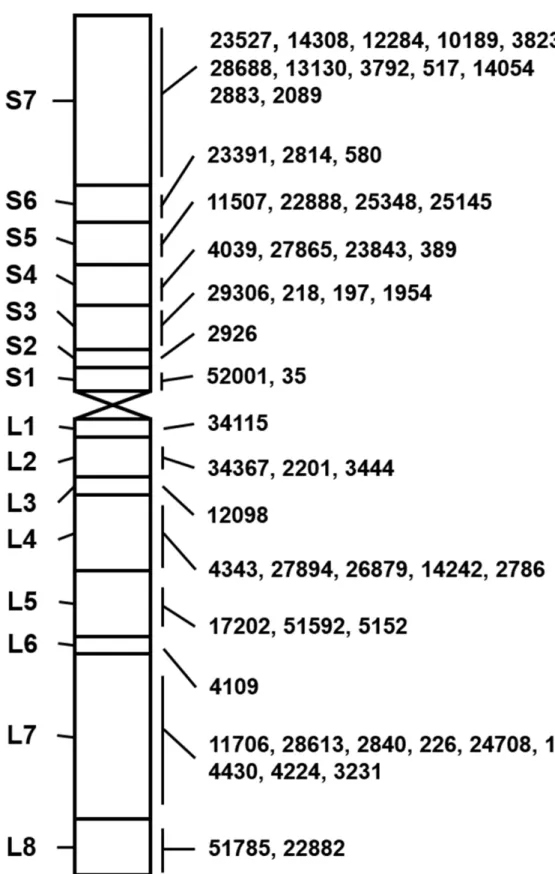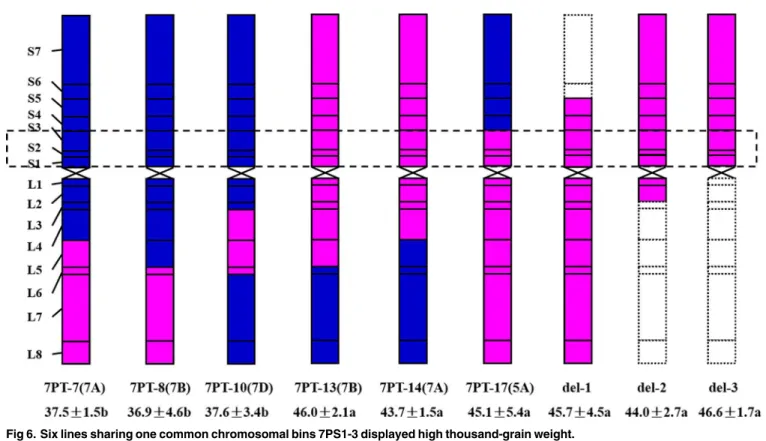Transferring Desirable Genes from
Agropyron
cristatum
7P Chromosome into Common
Wheat
Mingjie Lu☯, Yuqing Lu☯, Huanhuan Li, Cuili Pan, Yong Guo, Jinpeng Zhang,
Xinming Yang, Xiuquan Li, Weihua Liu*, Lihui Li*
National Key Facility for Crop Gene Resources and Genetic Improvement, Institute of Crop Science, Chinese Academy of Agricultural Sciences, Beijing 100081, China
☯These authors contributed equally to this work. *liuweihua@caas.cn(WL);lilihui@caas.cn(LL)
Abstract
Wheat-Agropyron cristatum7P disomic addition line II-5-1, derived from the distant hybrid-ization betweenA.cristatum(2n= 4x= 28, PPPP) and the common wheat cv. Fukuhoko-mugi (Fukuho), displays numerous desirable agronomic traits, including enhanced thousand-grain weight, smaller flag leaf, and enhanced tolerance to drought. In order to transfer these traits into common wheat, II-5-1 was induced by60Co-γray, leading to the
creation of 18 translocation lines and three deletion lines. Genomicin situhybridization (GISH) and fluorescencein situhybridization (FISH) indicated that multiple wheat chromo-somes were involved in the translocation events, including chromosome 2A, 3A, 5A, 7A, 3B, 5B, 7B, 3D and 7D.A.cristatum7P chromosome was divided into 15 chromosomal bins with fifty-five sequence-tagged site (STS) markers specific toA.cristatum7P chromo-some. Seven and eight chromosomal bins were located on 7PS and 7PL, respectively. The above-mentioned translocation and deletion lines each contained different, yet overlapping 7P chromosomal fragments, covering the entireA.cristatum7P chromosome. Three trans-location lines (7PT-13, 7PT-14 and 7PT-17) and three deletion lines (del-1, del-2 and del-3), which contained the common chromosomal bins 7PS1-3, displayed higher thousand-grain weigh than Fukuho, suggesting that potential genes conferring high thousand-grain weigh might be located on these chromosomal bins. Therefore, wheat-A.cristatum7P transloca-tion lines with elite traits will be useful as novel germplasms for wheat genetic improvement.
Introduction
Bread wheat (Triticum aestivumL.), serving as a major source of calories, is one of the most important crops in the world. However, genetic improvement of wheat for high yield and qual-ity to meet the demand from an ever-growing population has become challenging, as wheat breeding has been bottlenecked by a decreasing genetic diversity [1,2]. Therefore, researchers are persistently seeking for novel germplasms with broad genetic diversity for wheat genetic improvement.
a11111
OPEN ACCESS
Citation:Lu M, Lu Y, Li H, Pan C, Guo Y, Zhang J, et al. (2016) Transferring Desirable Genes from Agropyron cristatum7P Chromosome into Common Wheat. PLoS ONE 11(7): e0159577. doi:10.1371/ journal.pone.0159577
Editor:Aimin Zhang, Institute of Genetics and Developmental Biology, CHINA
Received:April 14, 2016
Accepted:July 4, 2016
Published:July 26, 2016
Copyright:© 2016 Lu et al. This is an open access article distributed under the terms of theCreative Commons Attribution License, which permits unrestricted use, distribution, and reproduction in any medium, provided the original author and source are credited.
Data Availability Statement:All relevant data are within the paper and its Supporting Information files.
Funding:This work was supported by the National Key Technology Support Program of China (Grant No. 2013BAD01B02, to LL), the National Natural Science Foundation of China (Grant No. 31271714, to YL), and the CAAS Innovation Team Project (to LL). The funders had no role in study design, data collection and analysis, decision to publish, or preparation of the manuscript.
One effective approach to create novel germplasms is to transfer desirable genes conferring superior agronomic traits into common wheat from its wild relatives. This approach has been successfully employed in wheat improvement. For example, yield-related genes located onTh. bessarabicumchromosome arm 2JS were transferred into common wheat through wheat-Th. bes-sarabicumtranslocation line T2JS-2BS2BL [3]. The genes conferring longer spikes and more kernels, as well as the seed storage protein genes conferring positive effect on bread making qual-ity, were transferred into common wheat fromDasypyrum villosum, respectively [4–5]. Two new wheat-Thinopyrum ponticumtranslocation lines RWG33 and RWG34 were found to carrySr43, which was resistant to the Ug99 race complex [6]. Stem rust resistance genesSrTA10187and SrTA10171were both derived fromAegilops tauschii[7]. Two T1BL1RS translocation lines derived from the crosses between common wheat cultivar and rye, showed high stripe rust resis-tance and good quality [8]. Taken together, a large number of desirable genes have been success-fully transferred into common wheat, resulting in a plenty of novel wheat germplasm. Thus far, several translocation lines have been widely used in wheat breading, and the two typical examples were wheat-rye 1BL1RS and wheat-Haynaldia villosa6VS6AL translocation lines [9–11].
Agropyron cristatum(L.) Gaertn. (2n= 4x= 28, PPPP), one of the most important wild rela-tives of wheat, harbours multiple desirable agronomic traits, such as enhanced grain number per spike, multiple floret per spikelet, resistance to diseases, and tolerance to abiotic stresses [12–15]. In order to exploit these traits and transfer them into common wheat, distance hybrid-ization between the common wheat cv. Fukuhokomugi (Fukuho) andA.cristatumwas carried out in 1990s [16–19]. F1hybrids were obtained successfully, and then a series of wheat-A.
cris-tatumdisomic addition lines were acquired [20–22]. These wheat-A.cristatumdisomic addi-tion lines were backcrossed with Fukuho or self-pollinated for several generaaddi-tions, until all of them displayed stable agronomic traits. Thus far, several wheat-A.cristatumdisomic addition lines have been induced, producing various translocation, substitution, deletion and introgres-sion lines [15,23–25]. For example, wheat-A.cristatum6P addition line 4844–12 was used as the fundamental material to produce numerous wheat-A.cristatum6P derivatives, some of which contain genes conferring enhanced grain number per spike [15,26], enhanced fertile til-ler number per plant [23]. It’s also reported that wheat-A.cristatumdisomic 2P addition line II-9-3 was induced, producing various wheat-A.cristatum2P derivatives with high resistance to powdery mildew [27].
The wheat-A.cristatumdisomic 7P addition line II-5 was found to display small flag leaf, enhanced thousand-grain weight, tolerance to drought. In order to transfer these elite traits into common wheat, II-5-1 was irradiated with60Co-γ. Various wheat-A.cristatum7P
deriva-tives were acquired, Among them 18 translocation lines and three deletion lines were studied in this project. Cytological and molecular methods were applied to figure out the genetic con-stitutions of the 21 lines; TheA.cristatum7P chromosome was divided into different chromo-somal bins, constructing the physical map ofA.cristatum7P chromosome. Besides, the agronomic traits, especially spike traits, were evaluated, and the chromosomal bins with thou-sand-grain weight-controlling genes were determined. Therefore, this study will not only pro-vide novel germplasm for wheat breeding but also help to understand the characterization of A.cristatum7P chromosome.
Materials and Methods
Plant materials
Irradiation of wheat-
A
.
cristatum
7P disomic addition line II-5-1
The II-5-1 plants were irradiated with60Co-γray at a dosage of 20 Gray (Gy) and a dose rate of
0.5 Gy/min, when the plants were at the booting stage [28]. All the irradiated plants were artifi-cially emasculated and pollinated with fresh pollens from the recipient parent Fukuho. F1seeds
were harvested, and then planted to produce the BC1F1and BC2F1populations.
Morphological indexes of II-5-1 at the germination stage
One hundred seeds from II-5-1 and Fukuho, respectively, were placed on filter paper with an osmotic potential of -0.5Mpa induced by the polyethylene glycol solution (PEG-6000) as described by Michael and Kaufman [29] and Gholamin et al. [30]. Mock treatment was con-ducted by using water. Each experiment was concon-ducted three times with three replicates each time. All Petri dishes were placed in a growth chamber for seven days at a temperature of 22 ± 2°C and 50% relative humidity. On the seventh day, multiple morphological indices including germination rate, germination index, coleoptile length, radicle number were recorded from 20 seedlings in each replication. Some morphological indices were calculated using the following formulas:
Germination rate = Total number of seeds germinated / Total number of seeds used x 100% Relative germination rate = Germination rate in PEG / Germination rate in water
Germination index was defined as:
Germination index = 1.0n1+6/7n2+5/7n3+4/7n4+3/7n5+2/7n6+1/7n7, where n1-n7 were germination rates from the first day to the seventh day.
GISH and FISH analysis
Genomicin situhybridization (GISH) was performed to detectA.cristatum7P chromosomal segments of II-5-1 as well as its derivative lines. The root tips of all the materials were harvested when they grew to about 2 cm, and the chromosomes were prepared as described by Song et al. [28]. Genomic DNA ofA.cristatumand Fukuho was isolated by CTAB method [31], and they were used as probe and block, respectively.A.cristatumgenomic DNA was labelled with digox-igenin-11-dUTP. Meiosis of II-5-1 were studied as described by Jauhar and Peterson [32]. Briefly, young spikes of II-5-1 at the pollen mother cells (PMCs) metaphase I (MI) stage were fixed in Carnoy’s solution (6-ethanol: 3-chloroform: 1-acetic acid) for 24 h and stored at 4°C until use. GISH was performed on the root tip cells and PMCs as described by Liu et al. [33].
To identify the translocated wheat chromosomes, fluorescencein situhybridization (FISH) was employed using repetitive DNA clonespAs1andpHvG39as probes, respectively [34].A. cristatumgenomic DNA and the clonepAs1were labeled by the Digoxigenin-Nick Translation Mix, while the clonepHvG39was labeled by Biotin-Nick Translation Mix. All the hybridization signals were observed using an OLYMPUS AX80 fluorescence microscope (Olympus Optical Co., Tokyo, Japan) and captured with a CCD camera (Diagnostic Instruments, Sterling Heights, MI, USA).
Construction of the physical map of 7P chromosome with STS markers
annealing temperature for 1 min, and at 72°C for 1 min, with a final extension at 72°C for 10 min. The amplified PCR products were separated by polyacrylamide gel electrophoresis (PAGE) with an acrylamide concentration of 8% and stained with silver.
Evaluation of agronomic traits
Plant materials were planted in 2.0 m rows, spaced 30 cm apart in the Beijing experiment sta-tion. The agronomic traits evaluated included the spike traits (grain number per spike, spikelet per spike, thousand-grain weight, grain length and grain width), the size of flag leaf, and also resistance to drought stress. The spike traits were measured as previously described [23]. Flag leaf length and width were measured at the milk stage. Drought tolerance evaluation was car-ried out as previously described [36]. Briefly, II-5-1 and Fukuho were treated with 20% Poly-ethylene glycol-6000 (PEG) after culturing for 7 days in water, and PEG-induced phenotypes were scored after 48 h.
Results
Characteristics of the wheat-
A
.
cristatum
7P disomic addition line II-5-1
II-5-1 was derived from the wide hybridization betweenA.cristatumand Fukuho, followed by self-pollination for six generations. GISH result showed that there were 44 chromosomes, including 42 wheat chromosomes and twoA.cristatumchromosomes (Fig 1A). Chromosomal pairing behavior in the pollen mother cells (PMCs) of II-5-1 was observed, and the chromo-somal configuration was 2n= 22 II; Besides, neither trivalents nor quadrivalents were observed (Fig 1B), suggesting that II-5-1 was a stable disomic addition line.
Fig 1. Identification of the wheat-A.cristatumdisomic addition lineII-5-1.a, GISH pattern of II-5-1 showing 42 wheat chromosomes (shown in blue) and twoA.cristatumchromosomes (shown in green and pointed by arrows); b, 21 bivalents are shown at the PMCs metaphase I (MI) stage of II-5-1; c-d, The morphologies of grain length (c) and width (d) of II-5-1 and Fukuho; e, The morphology of flag leaf of II-5-1 and Fukuho; f, The phenotype of seedling induced by PEG of II-5-1 and Fukuho.
II-5-1 displayed stable agronomic traits under three years’field observation. As shown in
Table 1, slight difference in plant height was observed between II-5-1 and Fukuho, but there was no significant difference in fertile tiller number per plant and spike length. II-5-1 showed enhanced thousand-grain weight and grain length compared with its recurrent parent Fukuho. The grain number per spike of II-5-1 was lower than that of Fukuho, and there was no signifi-cant difference in grain width and spikelet numbers per spike. The morphologies of grain length and grain width in II-5-1 and Fukuho were shown inFig 1C and 1D. As shown inFig 1EandTable 1, II-5-1 possessed narrower and shorter flag leaf compared with that of Fukuho. As shown inTable 2, relative germination rate, germination index, coleoptile length, radicle number of II-5-1 were higher than those of Fukuho, and relative germination index, relative coleoptile length, relative radicle number of II-5-1 were also increased compared with Fukuho, respectively. At the seedling stage, II-5-1 displayed less severe wilting than Fukuho (Fig 1F). These results suggested that II-5-1 displayed higher tolerance to drought compared with Fukuho. In sum, we propose that multiple elite agronomic traits in II-5-1, such as enhanced thousand-grain weight, longer grain length and higher tolerance to drought might be attributed to desirable alien genes from theA.cristatum7P chromosome.
Cytological identification of wheat-
A
.
cristatum
7P translocation and
deletion lines
In order to integrate the elite traits of II-5-1 into common wheat, wheat-A.cristatum7P addi-tion lineII-5-1 was irradiated with60Co-γray, and then backcrossed with the recipient parent
Fukuho. Then BC1F1seeds harvested from the irradiated plants were backcrossed with Fukuho
to obtain BC2F1plants. 219 BC1F1lines were acquired totally, among which 18 translocation
lines and three deletion lines were further investigated by GISH and FISH.
As shown inTable 3andFig 2, 18 translocation lines contained 42 chromosomes consisting of 41 wheat chromosomes, while three deletion lines contained 43 chromosomes consisting of 42 wheat chromosomes. 18 translocation lines were categorized into four translocation types, according to the relative size of the translocated chromosomal segments compared to either 7P chromosome arm (Fig 2andTable 3). These four types were as follows: whole-arm translocation, large segmental translocation, small segmental translocation and intercalary translocation.
Table 1. Agronomic traits of wheat-A.cristatumaddition line II-5-1 and Fukuho.
Materials Thousand-grain weight Grain length Grain width Grain numbers per spike Spikelet numbers per spike Flag leaf length Flag leaf width
Plantheight Fertile tiller numbers per
plant
Spike length
II-5-1 45.6±0.5a 7.84 ±0.05a
3.17 ±0.04a
30.6±2.3b 17.9±0.7a 17.3 ±1.9b
1.37 ±0.08b
105.0±2.3a 20.5±2.0a 11.1 ±1.2a Fukuho 38.4±2.3b 6.65
±0.10b 3.21 ±0.08a
63.5±5.0a 18.5±1.0a 24.6±2.5a 1.78 ±0.18a
93.0±3.7b 21.3±3.6a 10.6 ±0.9a
Significant differences in the mean are indicated at theP<0.05 (lowercase letters), based on T tests.
doi:10.1371/journal.pone.0159577.t001
Table 2. Morphological indices of II-5-1 and Fukuho induced by PEG at the germination stage.
Relative Germination Rate Germination Index Relative Germination Index Coleoptile Length Relative Coleoptile Length Radicle Number Relative Radicle Number
II-5-1 0.94 1.89±0.01a 0.85 23.4±1.1a 0.84 4.1±0.7a 0.95
Fukuho 0.88 1.83±0.01b 0.75 19.5±1.9b 0.71 3.3±0.5b 0.60
Significant differences in the mean are indicated at theP<0.05 (lowercase letters), based on T tests.
7PT-1 and 7PT-4 were both whole-arm translocation lines, in which translocation occurred to wheat chromosomes 3D and 5B, respectively. Seven small segmental translocation lines were identified (7PT-2, 7PT-6, 7PT-5, 7PT-9, 7PT-7, 7PT-3 and 7PT-8), in which translocation occurred on wheat chromosomes 2A, 3A, 5A, 5A, 7A, 3B and 7B, respectively. There were seven large segmental translocation lines (7PT-15, 7PT-12, 7PT-17, 7PT-14, 7PT-18, 7PT-16 and 7PT-13), which were translocated to 3A, 5A, 5A, 7A, 3B, 3A and 7B, respectively; 7PT-10 and 7PT-11 belonged to intercalary translocation lines, which were translocated to wheat chro-mosome 7DL and 7AS, respectively; However, only the short arm was left in 7PT-11, and the long arm was missing. GISH and FISH patterns of three translocation lines (7PT-8, 7PT-10 and 7PT-14) were shown inFig 3, and GISH and FISH patterns of other translocation lines were shown inS1 Fig. Beside 18 translocation lines, there were three deletion lines (del-1, del-2 and del-3) identified. There was only one chromosome arm left in del-3, and the other chromo-some arm was missing. There were partial chromosomal segments less than one chromochromo-some arm missing in del-1 and del-2.
Construction of the physical map of 7P chromosome
We further constructed the physical map ofA.cristatum7P chromosome with STS markers anchored to each bin. A large number of STS markers were screened to find those that can suc-cessfully be amplified in bothA.cristatumand II-5-1, and in at least one of the 21 translocation and deletion lines, but not in Fukuho, resulting in the discovery of 126 7P-specific STS markers. Among them, 55 STS markers displayed high amplification efficiency and reproducibility, and were chosen for downstream analysis (S1 Table). According to the co-occurrences of the STS
Table 3. 18 wheat-A.cristatum7P translocation lines and three deletion lines were acquired.
Materials Chromosome number Translocated wheat chromosomes Translocation types 7P chromosome bins Generations
7PT-1 42 3D 7PS3DL S1-7 BC1F1
7PT-2 42 2A 7PS-2AS2AL S4-7 BC1F1
7PT-3 42 3B 7PS-3BS3BL S5-7 BC1F1
7PT-4 42 5B 5BL7PL L1-8 BC1F1
7PT-5 42 5A 5AS5AL-7PL L4-8 BC1F1
7PT-6 42 3A 3AS3AL-7PL L4-8 BC1F1
7PT-7 42 7A 7AS7AL-7PL L5-8 BC1F1
7PT-8 42 7B 7BS7BL-7PL L6-8 BC1F1
7PT-9 42 5A 5AS5AL-7PL L8 BC1F1
7PT-10 42 7D 7DS7DL-7PL-7DL L4-6 BC1F1
7PT-11 42 7A 7AS-7PS-7AS S2-4 BC1F1
7PT-12 42 5A 7PS7PL-5AL S1-7, L1-7 BC1F1
7PT-13 42 7B 7PS7PL-7BL S1-7, L1-5 BC1F1
7PT-14 42 7A 7PS7PL-7AL S1-7, L1-4 BC1F1
7PT-15 42 3A 7PS7PL-3AL S1-7, L1 BC1F1
7PT-16 42 3A 3AS-7PS7PL S1-6, L1-8 BC1F1
7PT-17 42 5A 5AS-7PS7PL S1-3, L1-8 BC1F1
7PT-18 42 3B 3BS-7PS7PL S1-2, L1-8 BC1F1
del-1 43 N/A N/A S1-5, L1-8 BC1F1
del-2 43 N/A N/A S1-7, L1-2 BC1F1
del-3 43 N/A N/A S1-7 BC1F1
N/A: Not applicable
markers and 7P chromosomal bins in these translocation and deletion lines, the 55 STS mark-ers were mapped to different bins ofA.cristatumchromosome 7P, with 30 and 25 STS markers located on 7PS and 7PL, respectively (Fig 4). The chromosomal bins of 7PS and 7PL near the centromere were named as 7PS1 and 7PL1, respectively; while the chromosomal bins near the ends were named as 7PS7 and 7PL8, respectively (Fig 4). Each chromosomal bin contained dif-ferent STS markers, ranging from 1 to 12. The primer sequences of 55 STS markers were listed inS2 Table, and PCR amplification patterns of five markers were shown as examples inFig 5.
As shown inFig 2andTable 3, 18 translocation lines contained different chromosomal bins of 7PS and 7PL. Four translocation lines (7PT-1, 7PT-2, 7PT-3 and 7PT-11) only contained both 7PS or part of 7PS, and seven translocation lines (7PT-4, 7PT-5, 7PT-6, 7PT-7, 7PT-8, 9 and 10) contained both 7PL or part of 7PL. Four translocation lines (12, 7PT-13, 7PT-14 and 7PT-15) contained 7PS and part of 7PL, while three translocation lines (7PT-16, 7PT-17 and 7PT-18) contained 7PL and part of 7PS. The deletion line del-1 included the entire 7PL arm and 7PS1-5, del-2 included the entire 7PS and 7PL1-2, and del-3 only included the entire 7PS. From these results, we could infer that all the 7P chromosomal bins have been translocated onto wheat chromosomes. All these results indicated that variousA.cristatum7P
Fig 2. Eighteen wheat-A.cristatumtranslocation lines and three deletion lines were identified.The left map showing the schematic diagram ofA.cristatumchromosome 7P. Pink and blue color representedA.cristatum7P and wheat chromosomal segments, respectively. Dotted line boxes indicated the deleted chromosomal segments ofA.cristatum7P chromosome.
chromosomal bins were translocated onto 18 translocation lines and three deletion lines, and all these chromosomal bins can cover the entireA.cristatum7P chromosome.
Evaluation of spike traits of wheat-
A
.
cristatum
7P translocation and
deletion lines
Agronomic traits, especially the spike traits, were investigated in six translocation (7PT-7, 7PT-8, 7PT-10, 7PT-13, 7PT-14 and 7PT-17) and three deletion lines (del-1, del-2 and del-3) at the BC2F1generations. As shown inTable 4, three translcoation lines (7PT-13, 7PT-14 and
7PT-17) as well as three deletion lines displayed higher thousand-grain weight and longer grain length than those of Fukuho, respectively. However, there were no significant difference in both thousand-grain weight and grain length among other three translocation lines (7PT-7, 7PT-8 and 7PT-10) and Fukuho. There was no significant difference in grain width in all the nine lines as well as two parents. Besides, all the nine lines except 7PT-7 showed less grain number per spike than that of Fukuho, but some of them showed higher grain number per spike than that of II-5-1. There was no significant difference in spikelet number per spike
Fig 3. Three wheat-A.cristatumtranslocation lines identified by GISH and FISH.7PT-8 was the small chromosomal segment translocation line, which was translocated to wheat chromosome 7B (Fig 3A and 3D). 7PT-10 was the small chromosomal segment translocation line, which was intercalated into wheat chromosome 7D (Fig 3B and 3E). 7PT-14 was the large chromosomal segment translocation line, which was translocated to wheat chromosome 7A (Fig 3C and 3F). FISH patterns were shown in a-c, in which the clonepHvG39andpAs1was labeled green and red, respectively. GISH patterns were shown in d-f, in whichA.cristatumand wheat DNA was stained red and blue, respectively.
Fig 4. The physical map ofA.cristatum7P chromosome with 55 STS markers.Left panel: 15 chromosomal bins ofA.cristatum7P chromosome; Right panel: Physical locations of STS markers specific to 7P chromosome. The words "Agc" in front of the STS markers are omitted.
between two parents (II-5-1 and Fukuho), but all the nine lines except 7PT-7 and 7PT-10 con-tained more spikelet number per spike than that of either parent. As shown inFig 6, the chro-mosomal bins 7PS1-3 were present in three translocation lines (7PT-13, 7PT-14 and 7PT-17) and three deletion lines but absent in other three translocation lines. All the results suggested that there might be genes conferring high thousand-grain weight and grain length on the chro-mosome bins 7PS1-3 ofA.cristatumchromosome.
Discussion
Various translocation lines were produced by ionizing radiation
There are large quantities of elite genes in the wild relatives of wheat that can be used to improve the yield, quality, disease resistance and stress tolerance in wheat breeding. Generally speaking, creation of wheat alien addition lines is the first key step to transfer these desirable genes into common wheat. However, wheat alien addition line could not be used directly due to its large alien chromosomal segments. Therefore, wheat alien addition lines are often used as the fundamental materials to produce translocation lines with small alien chromosomal segments.
Fig 5. PCR amplification patterns of five STS markers.a,Agc23527; b,Agc389; c,Agc52001; d,Agc27894; e,Agc51785. 1, Marker; 2, Z559; 3, II-5-1; 4, Fukuho; 5, 7PT-3; 6, 7PT-2; 7, 7PT-1; 8, del-3; 9, 7PT-15; 10, del-2; 11, 7PT-14; 12, 7PT-13; 13, 7PT-12; 14, 7PT-16; 15, del-1; 16, 7PT-17; 17, 7PT-18; 18, 7PT-4; 19, 7PT-5; 20, 7PT-6; 21, 7PT-7; 22, 7PT-8; 23, 7PT-9; 24, 7PT-10; 25, 7PT-11.
doi:10.1371/journal.pone.0159577.g005
Table 4. Evaluation of the spike traits of some wheat-A.cristatumtranslocation and deletion lines.
Materials Translocation types Thousand-grain weight Grain length Grain width Grain number per spike Spikelet numberper spike
II-5-1 N/A 45.6±0.5a 7.84±0.05a 3.17±0.04a 30.6±2.3d 17.9±0.7d
Fukuho N/A 38.4±2.3b 6.65±0.10d 3.21±0.08a 63.5±5.0a 18.5±1.0d
7PT-7 7AS7AL-7PL 37.5±1.5b 6.74±0.08d 3.17±0.13a 60.5±7.8a 19.5±2.1bcd
7PT-8 7BS7BL-7PL 36.9±4.6b 6.69±0.25d 3.28±0.08a 35.3±4.1d 20.8±1.3abc
7PT-10 7DS7DL-7PL-7DL 37.6±3.4b 6.75±0.08d 3.34±0.08a 37.7±7.5cd 19.0±2.6cd
7PT-13 7PS7PL-7BL 46.0±2.1a 7.38±0.08bc 3.27±0.17a 29.7±4.5d 20.7±0.6abc
7PT-14 7PS7PL-7AL 43.7±1.5a 7.23±0.03bc 3.36±0.21a 50.5±7.8b 21.5±1.4ab
7PT-17 5AS-7PS7PL 45.1±5.4a 7.33±0.04bc 3.35±0.20a 38.0±6.8cd 21.0±1.4abc
del-1 N/A 45.7±4.5a 7.21±0.11c 3.30±0.21a 46.3±9.3bc 20.9±1.0abc
del-2 N/A 44.0±2.7a 7.41±0.14b 3.27±0.19a 37.0±7.5cd 21.7±2.1ab
del-3 N/A 46.6±1.7a 7.26±0.20bc 3.42±0.19a 48.5±4.9b 22.0±1.4a
Significant differences in the mean are indicated at theP<0.05 (lowercase letters), based on Duncan’s multiple range tests.
There were several methods to induce addition lines, such as gamma irradiation, CSph1b system and gametocidal chromosome. Considering the low level of pairing betweenA. crista-tumP genome and wheat ABD genomes, development of translocation lines by ionizing radia-tion seems to be a more appropriate approach [37]. Compared with other approaches, there’re much more chromosomal breakages by using this method, resulting in various translocation types [2]. In this study, 18 different wheat-A.cristatum7P translocation lines and three dele-tion lines were obtained, which was mainly attributed to multiple chromosomal breakages caused by60Co-γirradiation. Besides, two intercalary translocation lines (7PT-10 and 7PT-11)
were caused by double-strand chromosomal breakages. Therefore, ionizing radiation proved to be an effective way to produce translocation lines in this study. The effectiveness of gamma irradiation was also illustrated by several other examples. Various 6P and 2P translocation lines were produced from the wheat-A.cristatum6P addition line 4844–12 [28] and 2P addi-tion line II-9-3 by60Co-γirradiation [27], respectively. A series of structural aberrations
involvingThinopyrum bessarabicumchromosome 4J were obtained through gamma radiation [38]. Plenty of wheat-Haynaldia villosatranslocation lines withPm21were acquired by ioniz-ing radiation [39].
Establishment of the physical map of 7P chromosome with STS markers
Cytological methods such as GISH/FISH are often used to identify alien chromosomal seg-ments. However, these methods are ineffective in identifying small chromosomal segseg-ments. Moreover, it is not feasible to screen a large number of translocation lines by GISH/FISH, due to the fact that chromosome preparation and hybridization is quite labor-intensive and time-consuming. Compared with the cytological method, molecular marker is more effective to detect alien chromosomal segments. After genotyping the translocation line with molecular markers, we will get a general idea of the translocated chromosomal segments quickly.
Fig 6. Six lines sharing one common chromosomal bins 7PS1-3 displayed high thousand-grain weight.
In this study, 18 different translocation lines and three deletion lines were characterized by GISH/FISH and 55 STS markers.A.cristatum7P chromosome were divided into 15 chromo-somal bins depending on the presence or absence of STS markers, leading to the construction of the physical map of 7P chromosome. Once the physical map of 7P chromosome was con-structed, genes from this chromosome could be easily located on specific chromosomal bins. In this study, genes conferring enhanecd thousand-grain weight and grain length were prelim-inarily mapped on the chromosomal bins 7PS1-3. There’re other examples reported previously, showing the constructed physical maps with novel alien genes. For example, the physical map ofThinopyrum bessarabicumchromosome 4J consisted of 24 segmental blocks, and the blue-grained geneBaThbwas mapped on the block 4JL-11 [38]. The physical map ofA.cristatum 6P was built with 255 STS markers, and the leaf rust resistance genes were mapped on the region 6PS-0.81–1.00 [24].
Wheat-
A
.
cristatum
7P translocation lines are potentially valuable in
wheat breeding
Grain number per spike, fertile tiller number per plant and thousand-grain weight are three main factors determining wheat yield. Among these three factors, thousand-grain weight is least affected by environment [40]. Therefore, it’s important to increase thousand-grain weight in order to stably enhance the wheat yield. Thousand-grain weight is mainly determined by grain width, length and thickness [41–44]. In this study, wheat-A.cristatum7P addition line II-5-1 displayed enhanced thousand-grain weight and drought tolerance, and also a small flag leaf. It has been reported that a small flag leaf lead to higher photosynthetic rate of the whole plant and in turn higher grain weight [45,46]. A small flag leaf was also reported to reduce tran-spiration and enhance drought tolerance [47]. Whether the small size of the flag leaf in II-5-1 contributed to its high grain weight and drought tolerance remains to be investigated.
Among the 18 translocation lines reported in this study, six translocation lines (7PT-7, 7PT-8, 7PT-10, 7PT-13, 7PT-14 and 7PT-17) and three deletion lines (del-1, del-2 and del-3) displayed good agronomic performance (especially seeds-setting). According to FISH results, the translocations in all six translocation lines except 7PT-17 occurred on the wheat chromo-somes which belonged to wheat homoeologous group 7. These results suggested that wheat chromosome 5A, as well as 7B and 7A, conferred good homoeologous compensation withA. cristatumchromosome 7P. The good homoeologous compensation between 7P and 5A might be attributed by the genetic rearrangement ofA.cristatumchromosome 7P, and the similar phenomenon was also observed onA.cristatumchromosome 6P [48]. Three translocation lines and three deletion lines with chromosomal bins 7PS1-3 showed increased thousand-grain weight compared with Fukuho, while three translocation lines without chromosomal bins 7PS1-3 displayed decreased thousand-grain weight. The results suggested that there may be some genes conferring high thousand-grain weight on 7PS1-3. However, the agronomic traits of other translocation lines couldn’t be evaluated due to their bad seeds-setting, which might be caused by irradiation or poor compensation. The specific chromosomal locations and iden-tities of superior genes on the chromosomal bins 7PS1-3 conferring high thousand-grain weight still need further investigation. Therefore, to recover the genetic compensation and effectively utilize these lines in future breeding programs, we need to further reduce the linkage drag, preferably by back-crossing orph1bsystem.
Supporting Information
S1 Fig. Fifteen wheat-A.cristatumtranslocation lines were identified by GISH and FISH.
2; c, 3; d, 4; e, 5; f, 6; g, 7; h, 9; i, 11; j, 12; k, 7PT-13; l, 7PT-15; m, 7PT-16; n, 7PT-17; o, 7PT-18.
(PDF)
S1 Table. The PCR amplification results of 55 STS markers in all the materials. (XLS)
S2 Table. The primers sequences of 55 STS markers. (XLS)
Acknowledgments
The authors would like to thank the cobalt source chamber of Beijing University for irradiation treatment.
Author Contributions
Conceived and designed the experiments: LL WL. Performed the experiments: ML YL HL CP. Analyzed the data: ML YL LL WL. Contributed reagents/materials/analysis tools: YG JZ XY XL. Wrote the paper: YL ML.
References
1. Friebe B, Jiang J, Raupp W, McIntosh R, Gill B. Characterization of wheat-alien translocations confer-ring resistance to diseases and pests: current status. Euphytica. 1996; 91(1): 59–87.
2. Jiang J, Friebe B, Gill BS. Recent advances in alien gene transfer in wheat. Euphytica. 1993; 73(3): 199–212.
3. Qi Z, Du P, Qian B, Zhuang L, Chen H, Chen T, et al. Characterization of a wheat-Thinopyrum bessara-bicum(T2JS-2BS.2BL) translocation line. Theor Appl Genet. 2010; 121(3): 589–597. doi:10.1007/ s00122-010-1332-7PMID:20407740
4. Zhang R, Hou F, Feng Y, Zhang W, Zhang M, Chen P. Characterization of aTriticum aestivum-Dasy-pyrum villosumT2VS2DL translocation line expressing a longer spike and more kernels traits. Theor
Appl Genet. 2015; 128(12): 2415–2425. doi:10.1007/s00122-015-2596-8PMID:26334547
5. Zhang R, Zhang M, Wang X, Chen P. Introduction of chromosome segment carrying the seed storage protein genes from chromosome 1V ofDasypyrum villosumshowed positive effect on bread-making quality of common wheat. Theor Appl Genet. 2014; 127(3): 523–533. doi:10.1007/s00122-013-2244-0 PMID:24408374
6. Niu Z, Klindworth DL, Yu G, Friesen TL, Chao S, Jin Y, et al. Development and characterization of wheat lines carrying stem rust resistance geneSr43derived fromThinopyrum ponticum. Theor Appl Genet. 2014; 127(4): 969–980. doi:10.1007/s00122-014-2272-4PMID:24504553
7. Olson EL, Rouse MN, Pumphrey MO, Bowden RL, Gill BS, Poland JA. Introgression of stem rust resis-tance genesSrTA10187andSrTA10171fromAegilops tauschiito wheat. Theor Appl Genet. 2013; 126 (10): 2477–2484. doi:10.1007/s00122-013-2148-zPMID:23864229
8. Ji J, Wang Z, Sun J, Li J, Zhang X, Wang D, et al. Identification of new T1BL.1RS translocation lines derived from wheat (Triticum aestivumL. cultivar“Xiaoyan No. 6”) and rye hybridization. Acta Physiol Plant. 2008; 30(5): 689–695.
9. Chen P, Qi L, Zhou B, Zhang S, Liu D. Development and molecular cytogenetic analysis of wheat-Hay-naldia villosa6VS/6AL translocation lines specifying resistance to powdery mildew. Theor Appl Genet. 1995; 91(6–7): 1125–1128. doi:10.1007/BF00223930PMID:24170007
10. Tang Z, Fu S, Ren Z, Zhang H, Yang Z, Yan B, et al. Production of a new wheat cultivar with a different 1B.1R translocation with resistance to powdery mildew and stripe rust. Cereal Res. Commun. 2008; 36 (3): 451–460.
11. Tester M, and Langridge P. Breeding technologies to increase crop production in a changing world. Sci-ence. 2010; 327(5967): 818–822. doi:10.1126/science.1183700PMID:20150489
13. Dong Y, Zhou R, Xu S, Li L, Cauderon Y, Wang R. Desirable characteristics in perennial Triticeae col-lected in China for wheat improvement. Hereditas. 1992; 116: 175–178.
14. Johnson D. Seed and seedling relations of crested wheatgrass: a review. In: Johnson KL (ed) Crested wheatgrass: its values, problems and myths; symposium proceedings. Utah State Univ, Logan, UT, USA. 1986. pp. 65–90.
15. Wu J, Yang X, Wang H, Li H, Li L, Li X, et al. The introgression of chromosome 6P specifying for increased numbers of florets and kernels fromAgropyron cristatuminto wheat. Theor Appl Genet. 2006; 114(1): 13–20. PMID:17031609
16. Chen Q, Jahier J, Cauderon Y, Cauderon A. Cytological studies onAgropyronGaertn species from Inner Mongolia, China. C R Seances Acad Sci III. 1989; 309(11): 519–525.
17. Chen Q, Jahier J, and Cauderon Y. Production and cytogenetic analysis of BC1, BC2, and BC3 proge-nies of an intergeneric hybrid betweenTriticum aestivum(L.) Thell. and tetraploidAgropyron cristatum (L.) Gaertn. Theor Appl Genet. 1992; 84(5–6): 698–703. doi:10.1007/BF00224171PMID:24201360
18. Li L, and Dong Y. Hybridization betweenTriticum aestivumL. andAgropyron michnoiRoshev. Theor Appl Genet. 1991; 81(3): 312–316. doi:10.1007/BF00228669PMID:24221258
19. Limin A, Fowler D. An interspecific hybrid and amphiploid produced fromTriticum aestivumcrosses withAgropyron cristatumandAgropyron desertorum. Genome. 1990; 33(4): 581–584.
20. Li L. Cytogenetics and self-fertility of hybrids betweenTriticum aestivumL. andAgropyron cristatum (L.) Gaertn. Chinese Science Abstracts Series B; 1995.
21. Li L, Li X, Li P, Dong Y, Zhao G. Establishment of wheat-Agropyron cristatumalien additons lines. I. Cytology of F3, F2BC1, BC4, and BC3F1progenies. Acta Genetica Sinica. 1997; 24(2): 154–159.
22. Li L, Yang X, Zhou R, Li X, Dong Y. Establishment of Wheat-Agropyron cristatumalien addition lines. II. Identification of alien chromosomes and analysis of development approaches. Acta Genetica Sinica. 1998; 25(6): 538–544.
23. Ye X, Lu Y, Liu W, Chen G, Han H, Zhang J, et al. The effects of chromosome 6P on fertile tiller number of wheat as revealed in wheat-Agropyron cristatumchromosome 5A/6P translocation lines. Theor Appl Genet. 2015; 128(5): 797–811. doi:10.1007/s00122-015-2466-4PMID:25656149
24. Song L, Lu Y, Zhang J, Pan C, Yang X, Li X, et al. Physical mapping ofAgropyron cristatum chromo-some 6P using deletion lines in common wheat background. Theor Appl Genet. 2016; 129(5): 1023–
1034. doi:10.1007/s00122-016-2680-8PMID:26920547
25. Lu Y, Wu X, Yao M, Zhang J, Liu W, Yang X, et al. Genetic mapping of a putativeAgropyron cristatum-derived powdery mildew resistance gene by a combination of bulked segregant analysis and single nucleotide polymorphism array. Mol Breed. 2015; 35(3): 1–13
26. Luan Y, Wang X, Liu W, Li C, Zhang J, Gao A, et al. Production and identification of wheat-Agropyron cristatum6P translocation lines. Planta. 2010; 232(2): 501–510. doi:10.1007/s00425-010-1187-9 PMID:20490543
27. Li H, Lv M, Song L, Zhang J, Gao A, Li L, et al. Production and identification of wheat-Agropyron crista-tum2P translocation lines. PLoS One. 2016; 11(1): e0145928 doi:10.1371/journal.pone.0145928 PMID:26731742
28. Song L, Jiang L, Han H, Gao A, Yang X, Li L, et al. Efficient induction of wheat-Agropyron cristatum6P translocation lines and GISH detection. PLoS One. 2013; 8(7): e69501. doi:10.1371/journal.pone. 0069501PMID:23874966
29. Michel B, Kaufmann M. The osmotic potential of polyethylene glycol 6000. Plant Physiol. 1973; 51(5): 914–916. PMID:16658439
30. Gholamin R, Khayatnezhad M. Effects of polyethylene glycol and NaCl stress on two cultivars of wheat (Triticum durum) at germination and early seeding stages. Am Eurasian J Agric Environ Sci. 2010; 9 (1): 86–90.
31. Allen GC, Flores-Vergara MA, Krasynanski S, Kumar S, Thompson WF. A modified protocol for rapid DNA isolation from plant tissues using cetyltrimethylammonium bromide. Nat Protoc. 2006; 1: 2320–
2325. PMID:17406474
32. Jauhar PP, Peterson TS. Cytological analyses of hybrids and derivatives of hybrids between durum wheat andThinopyrum bessarabicum, using multicolour fluorescent GISH*. Plant Breed. 2006; 125(1): 19–26.
33. Liu W, Luan Y, Wang J, Wang X, Su J, Zhang J, et al. Production and identification of wheat-Agropyron cristatum(1.4P) alien translocation lines. Genome. 2010; 53(6): 472–481. doi:10.1139/g10-023PMID: 20555436
35. Zhang J, Liu W, Han H, Song L, Bai L, Gao Z, et al. De novo transcriptome sequencing ofAgropyron cristatumto identify available gene resources for the enhancement of wheat. Genomics. 2015; 106(2): 129–136. doi:10.1016/j.ygeno.2015.04.003PMID:25889708
36. Blum A, Sinmena B, Ziv O. An evaluation of seed and seedling drought tolerance screening tests in wheat. Euphytica. 1980; 29(3): 727–736.
37. Jubault M, Tanguy AM, Abélard P, Coriton O, Dusautoir JC, Jahier J. Attempts to induce homoeologous pairing between wheat andAgropyron cristatumgenomes. Genome. 2006; 49(2): 190–193. PMID: 16498469
38. Pu J, Wang Q, Shen Y, Zhuang L, Li C, Tan M, et al. Physical mapping of chromosome 4J of Thino-pyrum bessarabicumusing gamma radiation-induced aberrations. Theor Appl Genet. 2015; 128(7): 1319–1328. doi:10.1007/s00122-015-2508-yPMID:25851001
39. Chen P, You C, Hu Y, Chen S, Zhou B, Cao A, et al. Radiation-induced translocations with reduced Haynaldia villosachromatin at thePm21locus for powdery mildew resistance in wheat. Mol Breed. 2013; 31(2): 477–484.
40. Li W, Gill BS. 2005. Genomics for cereal improvement. In: Cereal genomics: Springer; 2005. pp. 585–
634.
41. Gegas VC, Nazari A, Griffiths S, Simmonds J, Fish L, Orford S, et al. A genetic framework for grain size and shape variation in wheat. Plant Cell. 2010; 22(4): 1046–1056. doi:10.1105/tpc.110.074153PMID: 20363770
42. Song X, Huang W, Shi M, Zhu M, Lin H. A QTL for rice grain width and weight encodes a previously unknown RING-type E3 ubiquitin ligase. Nature genetics. 2007; 39(5): 623–630. PMID:17417637
43. Su Z, Hao C, Wang L, Dong Y, Zhang X. Identification and development of a functional marker of TaGW2associated with grain weight in bread wheat (Triticum aestivumL.). Theor Appl Genet. 2011; 122(1): 211–223. doi:10.1007/s00122-010-1437-zPMID:20838758
44. Zhang X, Wang J, Huang J, Lan H, Wang C, Yin C, et al. Rare allele ofOsPPKL1associated with grain length causes extra-large grain and a significant yield increase in rice. Proc Natl Acad Sci USA. 2012; 109(52): 21534–21539. doi:10.1073/pnas.1219776110PMID:23236132
45. Austin RB, Morgan CL, Ford MA, Bhagwat SG. Flag leaf photosynthesis ofTriticum aestivumand related diploid and tetraploid species. AoB Plants. 1982; 49(2): 177–189.
46. Simpson GM. Association between grain yield per plant and photosynthetic area above the flag-leaf node in wheat. Can. J. Plant Sci. 1968; 48(3): 253–260.
47. Donaldson E. Crop traits for water stress tolerance. Amer J Alternative Agr. 1996; 11(2–3): 89–94.
